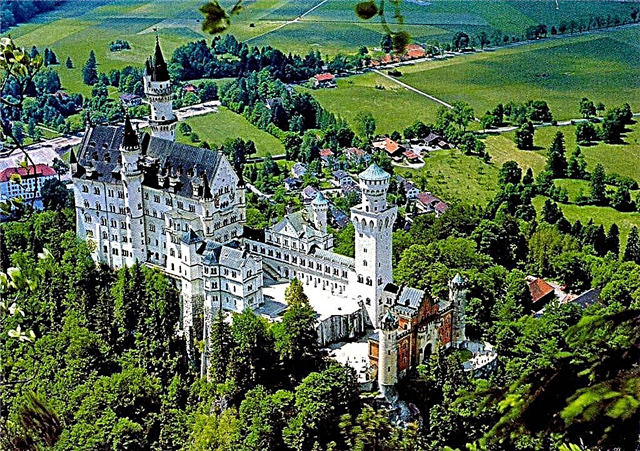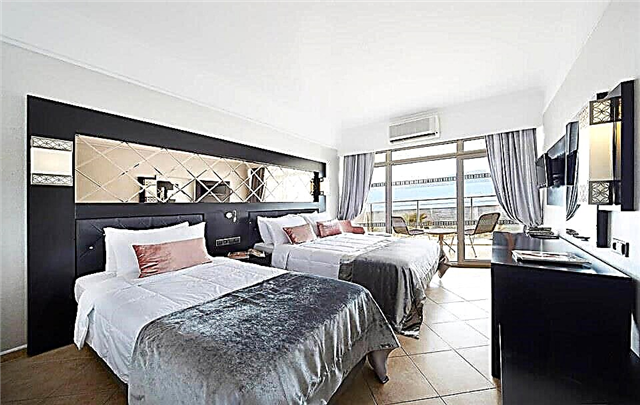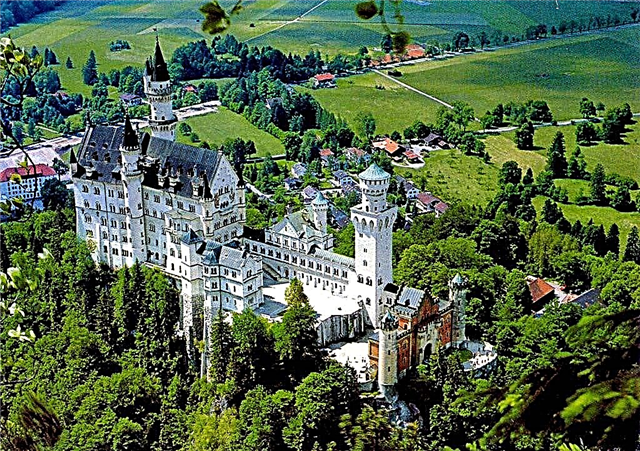The fabulous images created by Walt Disney not only delight and educate our children, but also transport adults into a wonderful time of fantasy and incredible opportunities. The image of the castle's pointed turrets begins the countdown before the start of the journey into a world where evil will always be defeated by good, where princesses and fearless knights live, where love and friendship conquers all earthly vices.

The castle, built at Disneyland Paris for Sleeping Beauty, served as the inspiration for the initial Disney logo. And now it is no longer a secret that the magic "house" for Beauty in the amusement park was a huge model of Neuschwanstein - a Bavarian castle hidden in the Alps. Another interesting castle in Germany that deserves attention is Burg Eltz Castle.

Ludwig II
The Bavarian monarch Ludwig II, who ascended the throne in 1864, is affectionately referred to by the Bavarians as the “fairytale king”, and he is still recognized as the most mysterious historical personality of these lands. His whole life and even the mysterious death was accompanied by legends and speculation. And the main reason for this was the deep loneliness of the king, which from year to year he enjoyed with greater strength.

Before starting a conversation about any of the castles built by Ludwig II, every guide will certainly refer to the history of the life of the Bavarian king: to his childhood and adolescence, the time of his reign, and, of course, the overthrow and mysterious death.
The family estate of the Wittelsbach family, a feudal dynasty of medieval knights, was located on the shores of the most beautiful lake Schwansee ("swan lake") near the town of Füssen. This is the southeastern Bavarian land, bordering Austria, along which the historical road of the Roman conquerors "romantic strasse" (romantic road) passed. The great resettlement of the times of Claudius Augustus left along this route many towns and castles, reminiscent of the exploits and merits of medieval knights.

Hohenschwangau Castle, which existed until the 12th century, was raised from the ruins by Ludwig's father Maximilian II. Here, in the summer residence of the Wittelsbachs, the childhood and adolescence of a young offspring of a feudal family passed. The entire interior of the castle, including the wall tapestries, was saturated with romantic plots of medieval legends about Lohengrin - the swan knight, Tannhäuser, Parsifal and about Richard the Lionheart. The boy, imagining himself a participant in fairy-tale plots, and most of all inspired by the image of Lohengrin, grew up dreamy, impressionable, trying to retire from the realities of reality.

A connoisseur of nature, music and poetry, he also had a great architectural talent. This passion for construction was impressively realized during his reign. And the goal of his whole life was to translate his fantasies into real architectural designs. And there were many plans. Ludwig II wanted to build several castles, which were to become the embodiment of the sophistication of the era of chivalry and romanticism. But he managed to bring to life only three - Linderhof, Herrenchiemsee and Neuschwanstein. The construction of the latter was completed after the death of the monarch. But this did not stop Neuschwanstein from becoming the most popular castle to visit in all of Bavaria.

How to get there
Acquaintance with the castle begins from afar, even at the entrance to the village of Hohenschwangau, where all cars and tourist buses are parked. Already from here a "postcard" view of the fabulous structure, entrenched on the top of the mountain, opens. In contrast to European castles, which were built as defensive structures to demonstrate strength and power, Neuschwanstein looks like a puppet palace for a fairy-tale character, demonstrating a clear distance from real life.

But the reality is the streams of thousands of tourists striving to get inside the castle, and the terminal at the foot of the mountain, which allows you to purchase a "pass" to this fairy tale. The ticket is the registration of the visitor and the reservation of a place in the excursion group, indicating the start time. You can climb to the castle on foot (about an hour), by a special bus, or by a stylized old horse-drawn carriage with a colorful Bavarian coachman. Many people choose the latter option, thereby getting the opportunity to admire the unforgettable landscapes and imbued with the atmosphere of fabulousness in advance.

The observation deck near the foot of the castle allows you to see all the details of the surrounding landscape. And he's impressive! On one side, the Alpine peaks are reflected in the crystal waters of the Alpsee. To the right is a lush green valley with a white church of the village of Schwangau, and on the left, behind the chessboard profile of the Hohenschwangau castle, you can see the small lake Schwansee.
Despite its unimpressive size, it was this that was the inspirational landscape for Tchaikovsky's creation of his graceful Swan Lake. Of course, the composer's creative flight was born not only of the mesmerizing Bavarian landscapes. The birth of images and magical music was directly related to Wagner's opera and the legend of the swan knight Lohengrin.

When talking about Neuschwanstein, one cannot fail to mention the special attitude of King Ludwig II to the German composer. As a sixteen-year-old boy, the king was fascinated by Wagner's music at the premiere of Lohengrin. All his inspired fantasies were embodied on that stage, and a few years later the king met the great composer. Throughout his life, the "fairy-tale king" was a philanthropist and patron of the musician. He dreamed that Wagner would write his future creations in Neuschwanstein's Swan Castle.
We also recommend:
- Public transport in Europe
- What to see in Munich in 1 day
- Berlin itinerary for 1 day
- How to get to Germany
- Mainz Cathedral in Germany
- Black Forest (Black Forest), Germany
Building
The construction of Neuschwanstein ("New Swan Cliff") was determined on the site where the two fortresses of Schwangau, already destroyed by time, were previously located. Artificial undermining of the rock made it possible to create a site for future construction. A road and a pipeline were laid to the top of the mountain, after which, immediately, in 1869, construction began, the pace of which surprised the whole district.

I must say that being an ardent adherent of all the innovations of technical progress of that time, Ludwig II strove to apply them in the implementation of his projects. To facilitate the transportation of goods and building materials, a steam crane and locomotives were used at the construction site. The novelties of technical progress were also used inside the architectural masterpiece: plumbing, central heating and a telephone system.
The creators of the project, architect Eduard Riedel and set designer Christian Jank, presented over 60 sketches to the king. And since the idea itself was entirely devoted to Wagner, the inspiration of the creators was based on the impressions of the Wartburg castle, located in the Thuringian Forest, where the legendary "Competition of Singers" was held in the 11th century. According to the project, which, unfortunately, was not given to be fully realized, a palace, women's chambers, a donjon, a knight's house and an entrance gate were planned in the castle ensemble.

Architecture
The entrance gate, crowned with the Bavarian coat of arms, welcomes visitors to the castle with bright colors of red brick and yellow sandstone. From the territory of the courtyard, framed by two terraces, a journey through the interiors of the castle begins. The guides, with great love, even with some servility, tell about every corner of the buildings where it is possible to take visitors.
Almost everything amazes: the ideas of the project, the location, the purpose of certain rooms and interior items. Compositions of facades thought out to the smallest detail, interior decoration of rooms and "surprises" of interiors create the impression that theatrical action can unfold here at any moment. In Neuschwanshein, obviously, the basic rule of plot intrigue is observed: with each step, interest increases.
There are many architectural and interior "surprises" here that amaze the imagination of visitors. By 1886, of the 80 rooms of the castle planned by the king, only 15 were completed. Most of them are very chambered. The rooms are designed for only one person - Ludwig himself. The carpet paintings covering the walls of each of the rooms reveal different plots of medieval legends and, of course, Wagner's operas.
The Singers' Hall
Returning to Ludwig II's favorite Wanger, I must say that the Singers 'Hall became the main hall, which was intended for a grandiose musical perspective with theatrical performances and singers' competitions. The massive trapezoidal oak ceiling that covers the room not only makes a strong impression with its shape and decor, but also serves as an excellent resonator for sound, creating wonderful acoustics. A conventional small stage, as it were, is always ready to unfold the action and fill the hall with music lovers. But, sadly, Wagner, to whom the creation of this Hall was dedicated, has never been here.
The tour of the castle takes place in succession through all the living quarters of the palace, in which the Bavarian monarch managed to live a little more than five months. And here surprises await visitors astonished by the decoration.
Library
Moving through the salon - the library, the design of which is entirely dedicated to Parsifal and Lohengrin, the guide stops his attention on a small, carved door. The surprise that opens behind the oak sections will delight and amaze everyone. There is a grotto here. An artfully crafted cave with a swimming pool and lighting is the place where the king meets nature. According to the project, the grotto is a through room. From there, the monarch could get into his office, where the surroundings again corresponded to the general style of the castle.
Throne room
The pinnacle of emotional impressions from the castle is the Throne Room, which occupies three floors of the western wing of the palace. Here, in every detail, the neo-Byzantine style is maintained: the perimeter of the room is framed by columns, the basilica is topped by a 15-meter dome with images of canonized monarchs. The walls, painted in a romantic style, show various battle scenes of the Crusades, and there is not a drop of blood on their depiction. The ensemble is completed by a majestic gilded chandelier with 96 candles, cast from bronze in the shape of a Byzantine crown, a symbol of absolute sovereign power.
And one more, now sad "surprise". A staircase of 9 steps in the Throne Room leads to the marble podium, where the throne is supposed to rise. But they did not have time to make it during the life of the monarch, so this place remained empty. It is here that a complete understanding of the unfinished image of the ruler of Bavaria comes, who did not manage to realize all his fantastic plans.
I also recommend reading Count Dracula's Castle. Fantastic reality, Frankenstein Castle.











